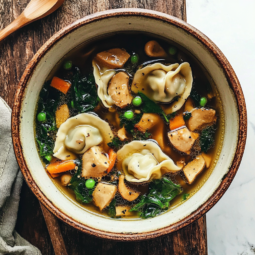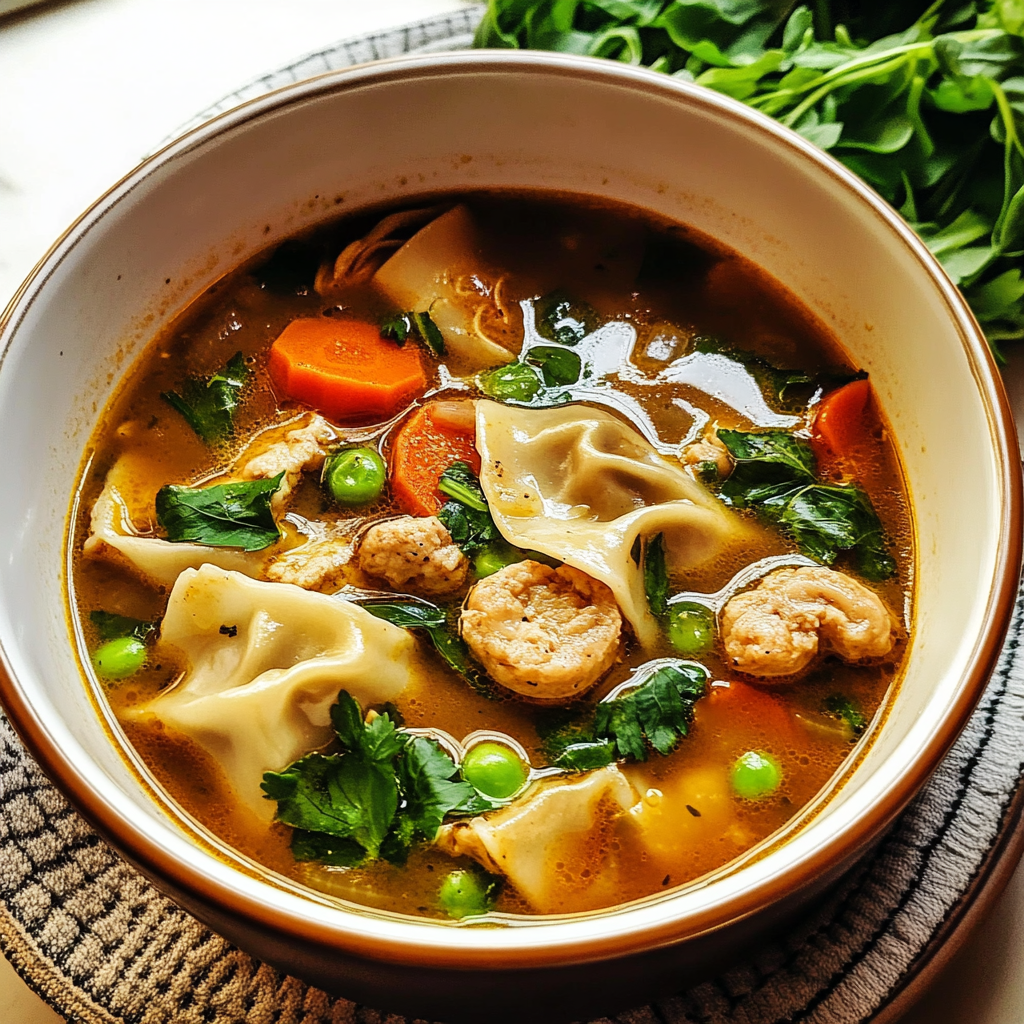Introduction and Basics of Potsticker Soup
Potsticker soup is a comforting, flavorful dish that brings together the warmth of soup and the irresistible taste of dumplings. Whether you’re a fan of traditional potstickers or looking for an exciting twist on classic Asian cuisine, this dish has something for everyone. In this guide, we’ll dive into everything you need to know about preparing, customizing, and enjoying potsticker soup.
What is Potsticker Soup?
At its core, potsticker soup is a harmonious blend of dumplings, a flavorful broth, and complementary vegetables or proteins. Originating from Asian culinary traditions, this dish combines the comfort of a hearty soup with the satisfying chewiness of potstickers. Unlike wonton soup or other dumpling-based dishes, potsticker soup often uses pan-seared dumplings, giving them a distinct flavor and texture.
Looking to learn about more authentic Asian soup recipes? Check out this guide for inspiration.
Why is Potsticker Soup Popular?
The popularity of potsticker soup lies in its flexibility and accessibility. It can be made with store-bought dumplings for convenience or handcrafted from scratch for those who enjoy cooking as an art. The broth, which serves as the foundation, can be tailored to individual tastes—ranging from rich chicken stock to lighter vegetable or miso-based broths.
For a deeper dive into authentic Asian soup recipes, this guide provides excellent inspiration for elevating your culinary game.
The Basics of Potsticker Soup
- Key Components:
- Potstickers: These can be filled with pork, chicken, shrimp, or vegetarian ingredients such as tofu and vegetables. They’re often seared before adding to the soup for a golden, crispy base.
- Broth: The broth can vary depending on personal preference. Chicken, vegetable, or even a spicy miso base works wonderfully.
- Vegetables: Popular choices include bok choy, napa cabbage, mushrooms, carrots, and green onions.
- Seasoning: Soy sauce, sesame oil, and garlic are common for enhancing the dish’s flavors.
- How It Differs from Other Dumpling Soups: While similar to wonton soup and gyoza soup, potsticker soup stands out because of the pan-seared texture of the dumplings, which adds a unique richness and slight crispness.
How to Make Potsticker Soup
Traditional Potsticker Soup Recipe
Here’s a simple, step-by-step guide to making potsticker soup:
- Ingredients:
- 12-15 frozen or homemade potstickers (vegetarian or meat-based).
- 4 cups of chicken or vegetable broth (low sodium recommended).
- 2 cups of chopped vegetables (e.g., bok choy, carrots, and mushrooms).
- 1 tablespoon soy sauce.
- 1 teaspoon sesame oil.
- Optional toppings: green onions, cilantro, or chili oil.
- Instructions:
- Prepare the Broth:
Heat a medium pot over medium heat. Add sesame oil and sauté the vegetables for 3-4 minutes until they begin to soften. - Simmer the Soup:
Add the broth and soy sauce to the pot. Bring the mixture to a gentle simmer, allowing the flavors to meld. - Cook the Potstickers:
Carefully add the potstickers to the simmering broth. Cook them according to package or recipe instructions, typically 8-10 minutes, ensuring they’re fully heated through. - Serve and Garnish:
Ladle the soup into bowls and top with green onions, cilantro, or a drizzle of chili oil for added heat.
Enjoy this classic dish, perfect for a quick dinner or a comforting weekend treat!
Variations to Try
Potsticker soup is highly versatile, allowing you to experiment with flavors and ingredients to create your ideal version. Here are some of the most popular variations to try:
1. Vegetarian or Vegan Potsticker Soup
- Swap meat-filled potstickers with vegetarian options made with tofu, mushrooms, or vegetables.
- Use vegetable broth instead of chicken broth for a lighter, plant-based option.
- Enhance the flavor with umami-rich ingredients like miso paste or nutritional yeast.
2. Gluten-Free Potsticker Soup
- Opt for gluten-free dumplings made with rice paper or gluten-free wrappers.
- Ensure the soy sauce used is certified gluten-free, or substitute it with tamari.
- Include hearty vegetables like zucchini, spinach, or sweet potatoes to add bulk and texture.
3. Spicy Potsticker Soup
- Add a teaspoon of chili paste, Sriracha, or gochujang to the broth for a spicy kick.
- Incorporate spicy ingredients like jalapeños, red pepper flakes, or a drizzle of chili oil.
- Pair with pork or shrimp potstickers to balance the heat with savory richness.
Each variation can be customized further by adding unique herbs, spices, or additional proteins. With these options, you can cater to different dietary needs and flavor preferences while keeping the essence of potsticker soup intact.
For expert tips on crafting your own dumplings, read this guide on homemade techniques.

Potsticker Soup
Ingredients
12-15 potstickers (store-bought or homemade)4 cups chicken or vegetable broth (low sodium)2 cups vegetables (e.g., bok choy, mushrooms, carrots)1 tablespoon soy sauce1 teaspoon sesame oilOptional toppings: green onions, cilantro, chili oil
Instructions
Prepare the Vegetables: Sauté vegetables in sesame oil for 3-4 minutes over medium heat.Simmer the Broth: Add broth and soy sauce, then bring to a gentle simmer.Cook the Potstickers: Carefully place potstickers in the broth and cook for 8-10 minutes, ensuring they are tender and heated through.Serve and Garnish: Ladle into bowls and top with optional garnishes like green onions or chili oil.
Notes
- Use gluten-free potstickers and tamari for a gluten-free version.
- Freeze broth and potstickers separately for meal prep.
Tips for the Perfect Potsticker Soup
Making a delicious potsticker soup is all about the details. Here are some tips and tricks to ensure your dish is a success:
1. Choose High-Quality Potstickers
- If using store-bought dumplings, opt for brands with minimal preservatives and authentic flavors.
- For homemade potstickers, use fresh ingredients and seal them properly to prevent breaking during cooking.
2. Sauté Potstickers First
- For an authentic flavor and texture, lightly pan-sear the potstickers before adding them to the soup. This creates a golden, crispy base that enhances the overall dish.
3. Perfect the Broth
- Use a broth that complements your dumpling filling—chicken or pork broth for meat-filled potstickers, and vegetable or miso broth for vegetarian ones.
- Add aromatics like garlic, ginger, and green onions to elevate the flavor.
4. Avoid Overcooking Potstickers
- Add potstickers to simmering broth, not boiling, to prevent them from breaking apart. Cook them for the time specified, usually 8-10 minutes.
5. Customize the Toppings
- Garnish with fresh herbs like cilantro, green onions, or a drizzle of chili oil for extra flavor and presentation.
These small but effective adjustments will make your potsticker soup restaurant-quality in both taste and appearance.Tips for Making Homemade Cabbage Soup

Nutritional Benefits of Potsticker Soup
Potsticker soup can be a balanced meal, especially when packed with vegetables and lean proteins. Here’s a quick breakdown:
- Calories: A standard serving (about 2 cups with 4-5 potstickers) contains 300-400 calories. This can increase with added toppings like chili oil or sesame seeds.
- Macronutrients: Protein: The potstickers, especially those filled with pork, chicken, or tofu, provide 12-20 grams of protein per serving. This makes it a satisfying meal.Carbohydrates: Potstickers and vegetables contribute 30-40 grams of carbs, offering a steady source of energy.Fats: A moderate amount of 8-12 grams of fat, mostly from dumpling fillings and sesame oil, balances the dish.
- Vitamins and Minerals: Vitamin A and C: Vegetables like bok choy, carrots, and mushrooms boost the soup’s vitamin content, supporting immunity and skin health.Iron: Meat or tofu-filled potstickers provide a good source of iron, essential for energy production.Sodium: Broth and soy sauce may contribute higher sodium levels, but opting for low-sodium alternatives can keep it in check.
Curious about the health benefits of broth-based soups? Explore them here.
Perfect Pairings for Potsticker Soup
Enhance your meal with these side dishes and beverages:
- Side Dishes: Steamed or Spicy Edamame: A simple yet flavorful starter that pairs well with the soup’s hearty broth. Sprinkle with sea salt or toss in chili oil for extra zing.Spring Rolls or Egg Rolls: Crispy on the outside and filled with vegetables or meat, these provide a delightful contrast to the soft dumplings in the soup.Asian Slaw: Made with shredded cabbage, carrots, and a sesame-soy dressing, this refreshing salad adds crunch and acidity to balance the soup’s richness.
- Beverages:Green Tea or Jasmine Tea: The light, aromatic qualities of these teas cleanse the palate and enhance the soup’s flavors.Light Beer: A crisp lager or pilsner complements the savory broth and dumplings without overpowering them.White Wine: Pair with a dry Riesling or Sauvignon Blanc to bring out the broth’s subtle flavors.
- . Desserts : Mochi Ice Cream: Sweet and chewy, it’s the perfect way to finish the meal.Sesame Cookies: Light, nutty, and not overly sweet, they provide a satisfying crunch
Cultural Significance and Regional Variations of Potsticker Soup
Potsticker soup holds deep cultural roots in Asian cuisine, blending the traditions of dumpling-making with the comforting allure of broth-based dishes. Originating in China, potstickers, or jiaozi, were historically enjoyed during Lunar New Year celebrations as a symbol of wealth and prosperity. The evolution into potsticker soup brought a new dimension to this beloved dish, integrating the warmth and communal nature of soup.
Cultural Significance
In Chinese culture, dumplings symbolize togetherness and are often made as a family activity. Adding broth to potstickers not only creates a heartwarming meal but also reflects the communal spirit of sharing food. Beyond China, similar dumpling soups have gained popularity across Asia, including Japanese gyoza soup and Korean mandu-guk, each with its unique twist on ingredients and preparation.
Regional Variations
- China: Traditional jiaozi soup is often served with pork-filled dumplings in a light broth flavored with ginger and soy sauce.
- Japan: Gyoza soup features thin-skinned dumplings in a miso or soy-based broth with green onions and mushrooms.
- Korea: Mandu-guk, a winter favorite, combines dumplings with beef or anchovy broth, often garnished with egg ribbons and seaweed.
This rich history and adaptability make potsticker soup a dish that transcends borders while honoring its cultural origins.
Frequently Asked Questions (FAQs)
Can I freeze Potsticker Soup?
Yes, but it’s best to freeze the broth and potstickers separately. Combine them while reheating to maintain texture.
What’s the best broth for potsticker soup?
Chicken or vegetable broth with a splash of soy sauce and sesame oil works well. For a unique twist, try miso or spicy broths.
How long does it take to prepare potsticker soup?
From start to finish, it usually takes about 20-30 minutes, depending on the recipe.
Can I use other types of dumplings?
Absolutely! Wontons, gyoza, or even homemade dumplings make excellent substitutes.
Conclusion
Potsticker soup is a delightful combination of flavors, textures, and warmth that’s perfect for any season. With endless variations and simple preparation, it’s a dish that suits beginners and seasoned cooks alike. So why not try making your version today? Experiment with flavors, add your favorite vegetables, and enjoy this comforting classic.



